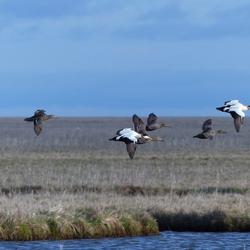Adaptive Management
Adaptive Management
Filter Total Items: 30
USGS Avian Research: Collaborative Science for Bird Management and Conservation
USGS scientists lead activities that are central to bird conservation and support both wildlife and communities. Through close collaboration with conservation partners, our scientists are meeting real-world needs—from maintaining sustainable harvest opportunities to advancing species recovery efforts.
Science in Flight: Seven Ways Bird Science Serves Society
Explore seven case studies highlighting how USGS bird research informs real-world decisions.
Key Values of a Century of EESC Science
The USGS Eastern Ecological Science Center (EESC) is rooted in a proud tradition of service to the nation—advancing science that informs the conservation and management of fish, wildlife, and habitats across the eastern United States and beyond. Our mission is clear: deliver reliable, partner-driven science that supports natural resource decisions today, while ensuring these resources remain...
Assessing vegetation and avian community response to juniper reduction treatments in Southwest Montana
The Southwest Montana Sagebrush Partnership (SMSP) team, including land managers, landowners, and scientists, is implementing conifer removal projects encompassing over 55,000 acres of private, state, and federal lands throughout the region. To date, little place-based information exists regarding likely vegetation and bird responses to such treatments in Southwestern Montana. To address this...
Sagebrush Trends Tool
This web-based mapping tool, released in 2024, enables users to identify which threats are driving the current status of Sagebrush Ecological Integrity (SEI), assess if SEI and associated threats, such as invasive annual grass, conifer encroachment, human modification - have changed over time, and visualize spatial trends in SEI and threats. The Sagebrush Ecosystem Trends Module supports managers...
Greater Sage-Grouse Population Monitoring Framework
Greater sage-grouse ( Centrocercus urophasianus) are at the center of state and national land use policies largely because of their unique life-history traits as an ecological indicator for health of sagebrush ecosystems. Researchers within the U.S. Geological Survey (USGS) and Colorado State University (CSU) worked with the Bureau of Land Management (BLM) and state wildlife agencies to develop a...
Data Harmonization for Greater Sage-Grouse Populations
Long-term wildlife monitoring is imperative for understanding population changes that can inform managers. However, working with population data collected by different organizations, across multiple jurisdictions, and over long time periods can be challenging due to different data management approaches and organizational priorities. Through this project, we aimed to collaborate with eleven state...
Modeling Songbird Density-Habitat Relationships to Predict Population Responses to Environmental Change Within Pinyon-juniper and Sagebrush Ecosystems
Within areas of overlapping sagebrush and pinyon-juniper ecosystems, wildlife populations are declining due to habitat fragmentation and degradation, changing environments, and human development. However, management to bolster species associated with one ecosystem may result in negative consequences for species associated with the other. Thus, land managers are challenged with balancing which...
Bighorn Sheep and Mountain Goat Research in Western National Park Units
Mountain goat and bighorn sheep are iconic symbols of many national lands in the West. Both species have limited distributions that can be difficult to observe and face multiple stressors including disease, increasing recreation in remote areas, and shifting weather regimes that influence their forage and thermoregulation. As species with relatively small population sizes, understanding...
Rainbow Trout in the Colorado River, Grand Canyon
Rainbow trout are a desirable sport fish that have been introduced in many locations around the world, including the Colorado River. Although introductions of rainbow trout and other nonnative fishes provide recreational fishing opportunities, they can also pose threats to native fish populations. The Glen Canyon Dam Adaptive Management Program has tasked scientists and managers with identifying...
A user-friendly decision support tool for monitoring and managing greater sage-grouse populations
Researchers within the U.S. Geological Survey (USGS) and Colorado State University (CSU) worked with BLM and State Wildlife Agencies to develop a hierarchical population monitoring framework for managing greater sage-grouse ( Centrocercus urophasianus) populations and the sagebrush ecosystems that they depend upon for survival and reproduction. This hierarchical population monitoring strategy now...
A targeted annual warning system (TAWS) for identifying aberrant declines in greater sage-grouse populations
Land and wildlife managers require accurate estimates of sensitive species’ trends to help guide conservation decisions that maintain biodiversity and promote healthy ecosystems. Researchers within the U.S. Geological Survey (USGS) and Colorado State University (CSU) worked with the Bureau of Land Management (BLM) and State Wildlife Agencies to develop a hierarchical population monitoring...













